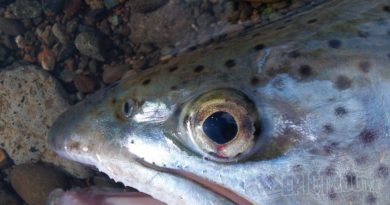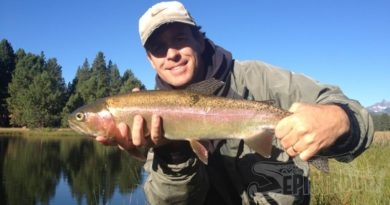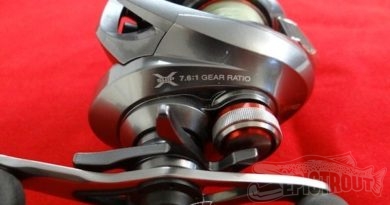Nielsen’s 7 keys tips
Master Tech Series: Nielsen’s 7 keys for trophy German browns
TAHOE CITY – There’s a closely guarded science to consistently catching big fish of any species, but in the case of trophy-class German browns in Northern California, there’s a whole ‘nother level of arcana that the best brown-baggers in the state protect like their checking account PIN numbers and Facebook passwords.
Brown baggers, in other words, can be sandbaggers. Ask a simple question, get an answer that would make a politician blush in embarrassment.
Not Mike Nielsen, though. The longtime Lake Tahoe big-brown pimp – he and his clients have boated fish running 15 pounds, 15 ounces (the current Tahoe record), 15-3, 14-8, 13-13 and 17 over 10 pounds – subscribes more to the notion that “none of us knows more than all of us” when it comes to sharing fish-catching knowledge. It’s how he (and the handful of buddies throughout the western Unites States he fishes with) have reached Olympic-class levels in pinpointing the biggest browns in their respective fisheries.
“A lot of us have had a lot of it right for years, but just a little bit of it wrong,” Nielsen admits. “You pick up these little bits of information from people and apply them to your process, and it makes you a better angler. If you’re open minded about it, you’ll learn things over the years that you might never figure out on your own.”
Open your minds, people, you’re about to receive info that might just correct your “little bit wrong” and connect you with the biggest brown of your life.
1. Speed kills … or at least catches bigger browns
Maybe it’s not a secret that bigger German browns seem attuned to fast-moving baits, but if you haven’t made this adjustment yet, do it now: speed up. More speed – be it trolling or casting – will almost always translate into the ultimate stimulator of the gnarliest hook-jawed browns in any lake system.
Nielsen says: “Maintaining an upbeat, fast pace is the one thing that will eliminate smaller fish, more than anything. You’ll get a predatory strike from the bigger fish, but more than anything, those smaller fish don’t want to try to track down baits that are moving 4 miles per hour. The bigger ones can get that done easy, but the smaller ones won’t pursue a bait like that.”
2. Speed, part 2: pump up the jam, literally
Effective trolling for trophy browns is not a lazy man’s folly. While a straight 3 ½ to 4 ½-mph troll will certainly catch you more big fish than a more sedate speed, you’ll attract even more predatory fish by actively working your rods while they’re sitting in the holders.
Nielsen says: “At the very least, do a lot of turns. Fish will hit on a turn when the bait speeds up on the outside, or slows down on the inside. I fish outriggers, too, so speed changes are even more pronounced because they’re 15 feet off the side of the boat. But even on the inside rods, I’m constantly pumping – call it ‘ripping’ or ‘strike trolling,’, it’s the reason why some of the best brown-trout fishermen have tennis elbow. I average around 45 pumps a minute when I’m trolling for big fish. If I’m running 3 ½ to 4 ½ miles per hour and pump the rod, it’ll speed up to almost 8 mph, and then come to almost a dead stop. When it does that ‘stop and go’ motion, fish will run up right behind it, look at it, and nine times out of 10, right when it’s just about to go when I pump it again, they’ll grab it. It’s just like a cat and yarn, where you’ll drag the yarn along really slow and they’ll stalk it, but right when you yank it a little and make it move faster, they’ll jump on it. Browns are just like that, too.”
3. Go big or go home
Big fish like big baits. Or, as CS steelhead writer Bill Herzog likes to say, “Eagles don’t eat worms.”
Nielsen says: “A 5- to 7-inch bait will almost always bring in bigger fish than a smaller 3- to 5-inch bait. Using a little larger lure can eliminate many of the smaller fish right out of the equation. My bread and butter baits are Rapala F11s, F13s and F18s, or CD09s or CD11s. The one exception I’d make to that is if you’re fishing with no chop on the water, on a really clear, sunny day where there’s a lot of visibility in the water. If it’s calm like that, maybe scale down to a Shad Rap to tone down your approach a little bit. Otherwise, bigger baits are the choice, hands down.”
4. Seek out structure – big fish do
Not unlike bass or pike in their predatory mannerisms, big German browns will utilize structure to their advantage to ambush prey. Plus, big browns tend to be aloof creatures: they like to hunker down around structure as a course of habit.
Nielsen says: “Even though Tahoe seems like an odd place to talk about structure, because I think most people think of structure as being trees and wood and such, it’s just structure on a bigger scale. Other lakes are like that, too. Instead of stumps, it might be shallow shoals or even open-water flats or sand bars. Big browns will use all of those as ambush points. In general you’ll find more fish of all sizes in rocky areas, but one thing you might be surprised it is how many big fish I’ll find on an open-water sand bar. Big fish will cruise over those because they’re really not afraid of anything, and it’s almost like an oversized piece of structure.”
5. Just a little ripple will suffice, thank you
While many brown baggers subscribe to the theory that the biggest browns only come out to play in the gnarliest weather – and it’s true, you do see many of the biggest fish of the year in the dead of late fall/early winter – it doesn’t take hurricane-force winds and black-cloud overcast to bring browns close to the surface.
Nielsen says: “Maybe 10 years ago, I felt like you had to have a really crappy weather day to get the biggest fish out, but all it really takes is a little diffusion on the water. Even on a more sunny day, all it takes sometimes is a little breeze to put a ripple on the water and really activate those fish. They’re definitely more willing to be out and close to the surface foraging and chasing bait if there’s a little bit of diffusion.”
6. Make a few gear tweaks
Subtle little changes to your standard gear will almost always enhance your ability to fool big, spooky browns. In other words, downsize and go into stealth mode.
Nielsen says: “If you haven’t made the switch to fluorocarbon yet, do it. And the same with braid for your mainline. I run Sufix 832 20-pound braid and a 20- to 30-foot leader of 10-pound Sufix Flurocarbon. I’ll go down t0 8 sometimes, and if you can go down to 6, go for it. Remember, though, you might get more strikes but you run the risk of losing more fish with that light of a leader. The braid mainline translates the action better if you’re pumping the rod, and you’ll get better hooksets.”
7. Think outside the (tackle) box
Even though he’s a troller by trade, Nielsen always keeps an open mind to techniques that you don’t normally associate with German browns. Mackinaw techniques, for example.
Nielsen says: “I haven’t done a lot of this yet, but I’m going to spend some time getting better at vertical jigging for big browns. We do it here on Tahoe for Mackinaw, but one of the best brown-trout fishermen I know caught four browns between 12 and 17 pounds this spring by jigging. You can fish then in 60 to 80 feet of water around the schools of kokanee, but I think it’d be a much better technique for murkier water. Tahoe is just so clear, I can almost see the bottom in 60 feet of water, so the fish might be spooky about the boat overhead. If you’re jigging, do it differently than you would with Mackinaw where you just run a 1- or 2-ounce jig down and just pump away. You can pick up movement on your sonar if a brown moves toward a jig. Just keep it away from them: bring it up a little, and get them to follow it. If they keep following, keep bringing it up. Eventually, they’re going to grab it and go back to their hidey-hole.”





